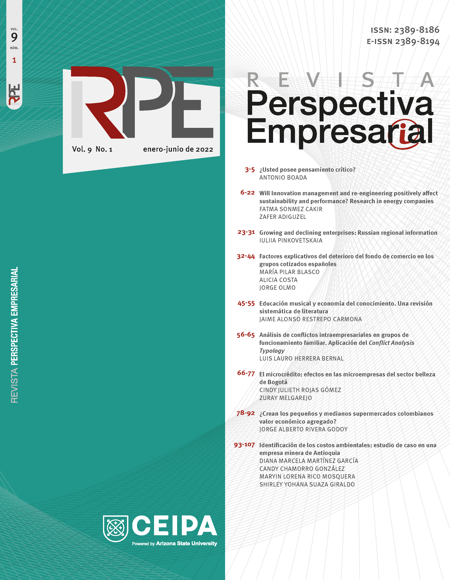Do small and medium-sized Colombian supermarkets create added economic value?
¿Crean los pequeños y medianos supermercados colombianos valor económico agregado?
##plugins.themes.bootstrap3.article.main##
Objective. To evaluate whether Colombian small and medium-sized companies in the supermarket industry create economic value added in the period 2014-2020 and whether the outcomes are consistent with their financial performance accounting indicators.
Methodology. A static and trend analysis of growth, efficiency, efficacy, effectiveness, economic value added and market value added indicators is performed. Results. SME supermarkets outperform small businesses in accounting performance because they are
more effective in managing costs and expenses and more efficient in the administration of assets, despite using less positive financial leverage. Also, SME supermarkets create added economic value: the small one in six years and the medium one in four. Conclusions.
Comparing the overall supermarket industry to SMEs reveals that the former is less effective
for being less efficacious and efficient, and uses less financial leverage; additionally, each year this sector destroys economic value added.
Downloads
##plugins.themes.bootstrap3.article.details##
Arnold, G. and Lewis, D. (2019). Corporate financial management. New York, USA: Pearson.
Atrill, P. (2017). Financial management for decision maker. New York, USA: Pearson.
Brealey, R., Myers, S. y Allen, F. (2020). Principios de finanzas corporativas. Ciudad de México, México: McGraw-Hill.
Brigham, E. y Ehrhardt, M. (2018). Finanzas corporativas. Enfoque central. Ciudad de México, México: Cengage Learning.
Chen, S. and Dodd, J. (1997). Economic Value Added (EVATM): An empirical examination of a new corporate performance measure. Journal of Managerial Issues, 9(3), 318-333.
Damodaran, A. (2021). Damodaran Online. Recuperado de https://pages.stern.nyu.edu/~adamodar/.
DANE. (2020). Clasificación industrial internacional uniforme de todas las actividades económicas. Revisión 4 adaptada para Colombia. CIIU Rev. 4 A.C.Bogotá, Colombia: DANE.
Dumrauf, G. (2017). Finanzas corporativas: un enfoque latinoamericano. Ciudad de México, México: Alfaomega.
EMIS Professional. (2021). ISI Emerging Markets Group.Recuperado de https://www.emis.com/.
Haro, D. y Monzón, R. (2020). Valor económico agregado como indicador en la gestión de negocios en las empresas. YACHANA, 9(2), 39-49. DOI: https://doi.org/10.62325/10.62325/yachana.v9.n2.2020.645
Martin, J. y Petty, J. (2001). La gestión basada en el valor. La respuesta de la empresa a la revolución del accionista. Barcelona, España: Editorial Gestión 2000.
Modigliani, F. and Miller, M. (1963). Corporate income taxes and the cost of capital: a correction. The American Economic Review, 53(3), 433-443
Obaidat, A. (2019). Is economic value added superior to earnings and cash flows in explaining market value added? An empirical study. International Journal of Business, Accounting and Finance, 13(1), 57-69.
Ortiz, H. (2018). Análisis financiero aplicado, bajo NIIF. Bogotá, Colombia: Universidad Externado de Colombia.
Rivera, J. y Alarcón, D. (2012). El cargo de capital en la evaluación del desempeño financiero de empresas innovadoras de confecciones de Cali. Estudios Gerenciales, 38(123), 85-100. DOI: https://doi.org/10.1016/S0123-5923(12)70206-1
https://doi.org/10.1016/S0123-5923(12)70206-1 DOI: https://doi.org/10.1016/S0123-5923(12)70206-1
Rivera, J. (2017). Introducción a la administración financiera: fundamentos y aplicaciones para crear valor. Cali, Colombia: Universidad del Valle.
Rivera, J., Giraldo, D. y Tello, D. (2021). Efectividad y valor económico agregado del sector supermercados en Colombia. Revista Universitaria Ruta, 23(2), 1-27.
Ross, S. et al. (2019). Corporate finance. New York, USA: McGraw-Hill.
Salaga, J., Bartosova, V. and Kicova, E. (2015). Economic value added as a measurement tool of financial performance. Procedia Economics and Finance, 26, 484-489. https://doi.org/10.1016/S2212-5671(15)00877-1 DOI: https://doi.org/10.1016/S2212-5671(15)00877-1
Sharma, A. and Kumar, S. (2012). EVA Versus Conventional Performance Measures - Empirical Evidence from India. Proceeding of ASBBS, 19(1), 804-815.
Stern, J.M. and Willett, J.T. (2014). A Look Back at the Beginnings of EVA and Value Based Management: An Interview with Joel M. Stern. Journal of Applied Corporate Finance, 26(1), 39-46. https://doi.org/10.1111/jacf.12052 DOI: https://doi.org/10.1111/jacf.12052
Stewart, B. (2000). En busca del valor. Barcelona, España: Editorial Gestión 2000.
Superintendencia Financiera de Colombia (2021). Tasa de interés y desembolsos por modalidad de crédito. Recuperado de https://www.superfinanciera.gov.co/jsp/loader.jsf?lServicio=Publicaciones&lTipo =publicaciones&lFuncion=loadContenidoPublica cion&id=60955.
Worthington, A. and West, T. (2001). Economic value added: A review of the theoretical and empirical literature. Asian Review of Accounting, 9(1), 67-86. https://doi.org/10.1108/eb060736 DOI: https://doi.org/10.1108/eb060736
Zutter, C. and Smart, S. (2019). Principles of managerial finance brief. New York: Pearson



































